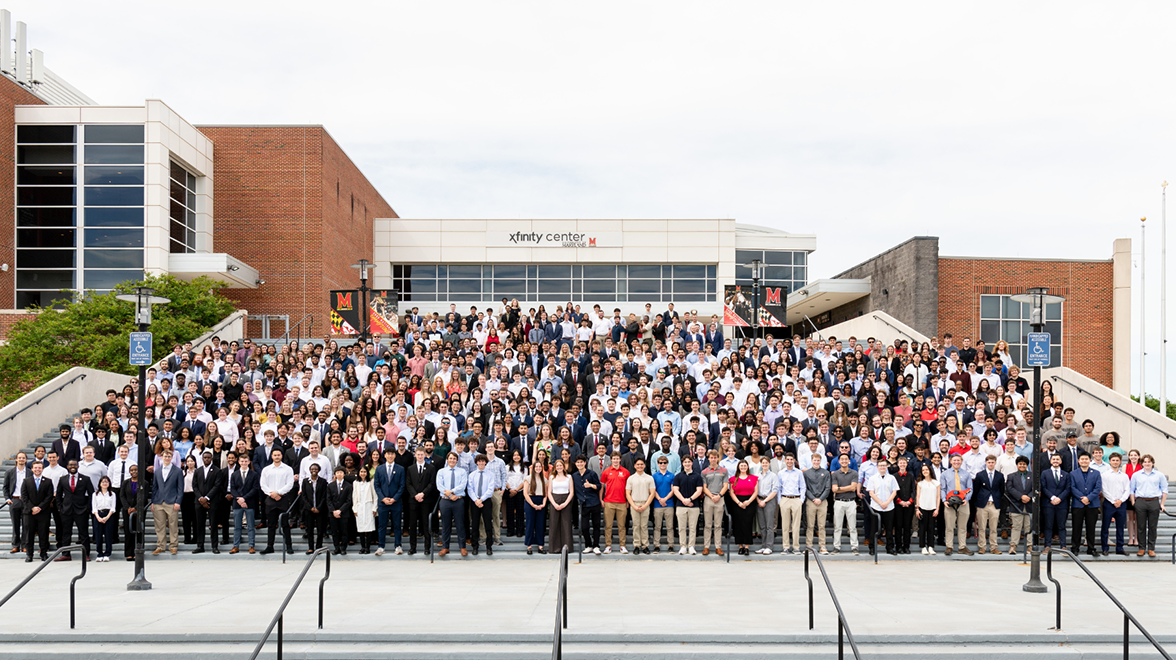
|
 |
More than 800 Clark School Seniors present projects to tackle real-world problems at the 2025 Capstone Design Expo. |
|
Engineering students showcased 134 solutions to society’s most pressing challenges at the second annual Capstone Design Expo, a culmination of semester- and year-long senior projects that saw winning teams from each department earning cash prizes.
The Expo expanded in 2025 to include all eight of Maryland Engineering’s departments—aerospace, bioengineering, chemical and biomolecular, civil and environmental, electrical and computer, fire protection, materials science and engineering, and mechanical—as well as Vertically Integrated Projects (VIP) Model for Experiential Learning at UMD.
The Whiting-Turner Contracting Company served as lead sponsor for the event. “Whiting-Turner is extremely appreciative of our relationship with the University of Maryland providing the next generation of engineers with incredible opportunities,” said Division Vice President Jason Spicer. “We are thrilled to have sponsored the 2025 Capstone Design Expo, showcasing hundreds of projects built by such talented engineering students and tomorrow's industry leaders. The future is bright!”
More than 800 engineering students were joined by more than 1,200 visitors, including industry representatives and proud parents. Projects were judged by experts in their respective fields, with each capstone team expected to demonstrate an ability to apply engineering fundamentals to design solutions while considering relevant technical and social outcomes, such as public health, safety, and welfare, as well as global, cultural, social, environmental, and economic factors. Sustainability was a key metric at this year’s Expo, with designated sustainability judges evaluating all projects.
“Terp engineers define the problems facing our state and society, and create solutions that are accessible to all. I am glad we could come together as a community tonight and showcase your incredible ideas and designs,” Clark School Dean Samuel Graham told participants at the event. “I’d like to thank our outstanding students: without your hard work, tonight’s Expo would not be possible.”
Department of Materials Science and Engineering Teams Model Safety, Sustainability
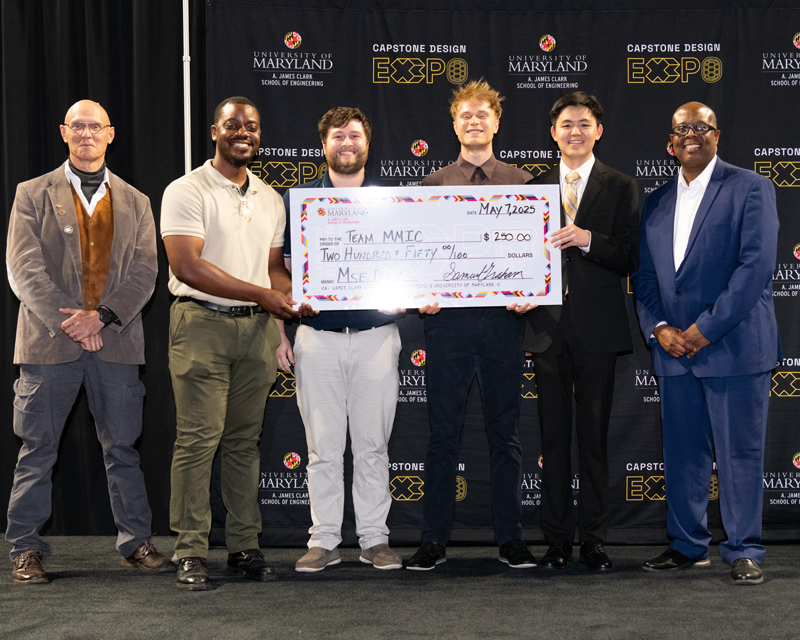 A member of materials science and engineering’s top team, MMIC (short for “Microlaminated Metal Intermetallic Composite Armor”), Joseph Odutola appreciated getting to see the wide range of projects from students in other departments. The coolest thing about winning? “Seeing the results of our efforts and time rewarded,” he said. “We hope to apply what we learned from this capstone project to our academic and career lives.” A member of materials science and engineering’s top team, MMIC (short for “Microlaminated Metal Intermetallic Composite Armor”), Joseph Odutola appreciated getting to see the wide range of projects from students in other departments. The coolest thing about winning? “Seeing the results of our efforts and time rewarded,” he said. “We hope to apply what we learned from this capstone project to our academic and career lives.”
In addition to Odutola’s team’s successful ballistics protection armor, nicknamed Big Momma, the department’s projects included a method for electrostatic dispersion of nanoparticles in polymer coatings, meant to rectify a common problem in colloidal chemistry, and a sustainable photoresist (polymers used in microelectronic fabrication) made from chitosan, a biopolymer sourced from shellfish waste. All materials science and engineering teams were guided by Professor Ray Phaneuf.
For team lead Kim Taylor, the chitosan bioresist project combined her current interests with her previous interests as a food science major. “When I started working in microelectronics I still had this interest in sustainability,” she said. “For my capstone project I wanted to combine a few ideas and try to model an option for designing silicon chips that reduces waste.”
Department of Chemical and Biomolecular Engineering Teams Develop Viable Energy-Related Techniques
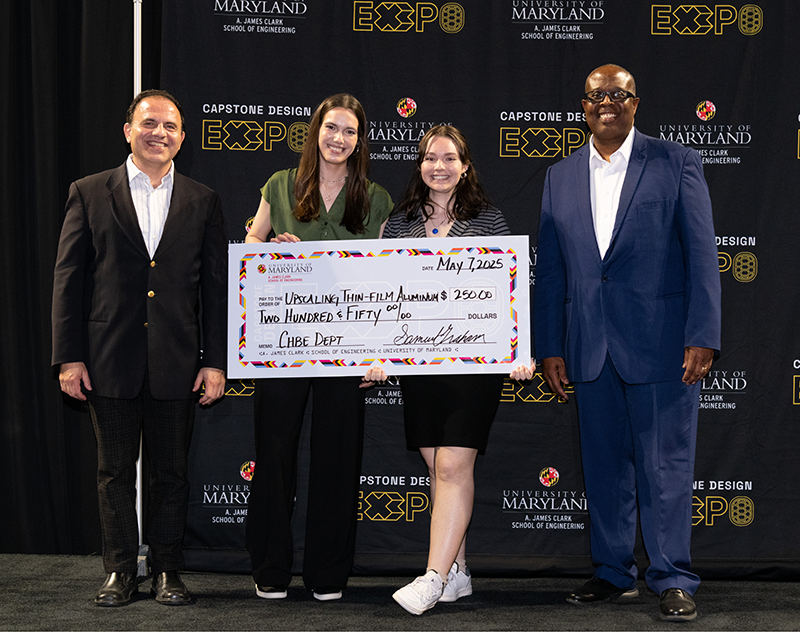 Chemical and biomolecular engineering teams simulated various chemical processes to solve a wide range of needs across industries. Departmental projects, all under the guidance of Associate Professor Nam Sun Wang, ranged from wastewater treatment to yeast and beer production, and air filtration to systems for battery applications. The winning project, “Upscaling Thin-Film Aluminum Oxide Production via Atomic Layer Deposition,” found their process to be a promising and economically sustainable technique for the growing markets using advanced microelectronics, nanotechnology, and protective coatings. Chemical and biomolecular engineering teams simulated various chemical processes to solve a wide range of needs across industries. Departmental projects, all under the guidance of Associate Professor Nam Sun Wang, ranged from wastewater treatment to yeast and beer production, and air filtration to systems for battery applications. The winning project, “Upscaling Thin-Film Aluminum Oxide Production via Atomic Layer Deposition,” found their process to be a promising and economically sustainable technique for the growing markets using advanced microelectronics, nanotechnology, and protective coatings.
Another team explored optimizing zinc ore refinement for battery grade zinc for use in applications including solar farms. “We wanted to make sure all our emissions were well below EPA limits,” said Trisha Ghosh of her team’s successful simulated process.
What the team hadn’t expected was that their process could offer an economically sustainable way to meet the growing demand for safe, grid-scale energy storage solutions. “We did our economic analysis, and the profit was a surprise,” she said.
Department of Fire Protection Engineering Teams Complete Local Safety Mission
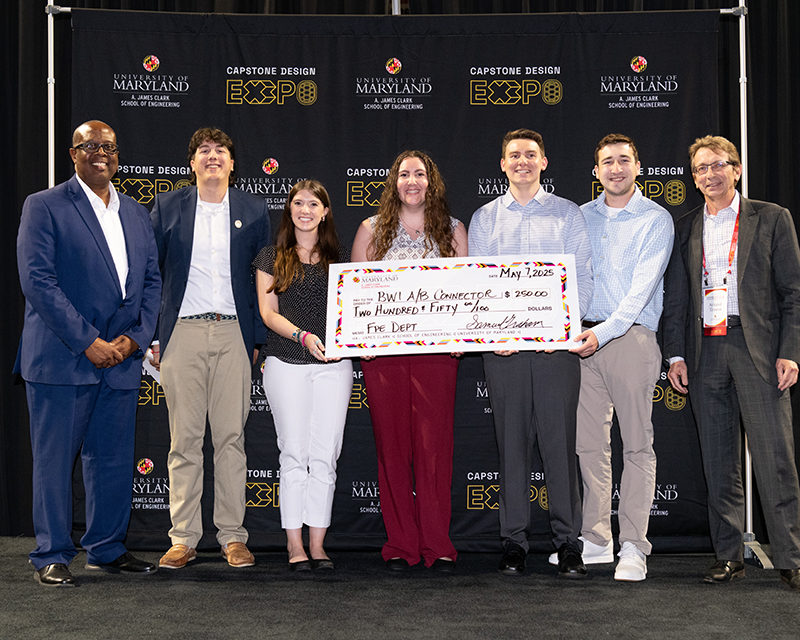 The Expo’s fire protection engineering project teams focused on one challenge: ensuring occupant safety in the new Baltimore/Washington International (BWI) Airport concourse A/B connector in the event of a fire scenario through fire protection measures. Designs varied, based on teams’ chosen features—including fire doors and walls, smoke partitions, and curtains—as well as notification systems and evacuation strategies. The Expo’s fire protection engineering project teams focused on one challenge: ensuring occupant safety in the new Baltimore/Washington International (BWI) Airport concourse A/B connector in the event of a fire scenario through fire protection measures. Designs varied, based on teams’ chosen features—including fire doors and walls, smoke partitions, and curtains—as well as notification systems and evacuation strategies.
The winning team’s renovation design, “BWI A/B Connector FPE Renovations by Rock Solid Fire Protection,” included fire-rated walls and ceilings and automatically closing fire doors. Working with representatives from fire protection company Jacobs and advised by Assistant Clinical Professor and two-time Terp Rosalie Hrybyk ’13, M.S. ’15, all teams worked toward the goal of maximizing life and safety while maintaining BWI mission continuity.
Tori Latham, a member of the FIRST IN Fire Protection team, found her team’s design to be successful and, “as far as construction costs go, fairly inexpensive,” she said. For the senior, the project had a direct application to her new position as a consultant for Jensen Hughes, which she will begin after graduation. “It was nice to work together in the same way we do in a real-world situation.”
Department of Mechanical Engineering Teams Build Accessibility and Safety Solutions
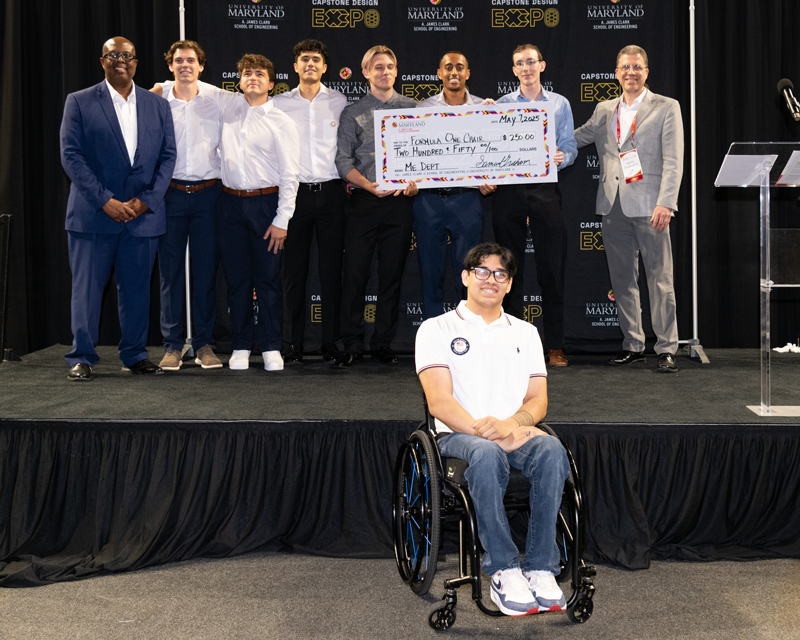 An Expo stand-out and mechanical engineering winner, team Formula One Chair was tasked to design and manufacture a “Wheelchair Propulsion Device” for wheelchair users to reduce physical strain and provide adjustable assistance levels based on individual needs. The team was advised by Associate Clinical Professor and Keystone Instructor Aris Cleanthous. An Expo stand-out and mechanical engineering winner, team Formula One Chair was tasked to design and manufacture a “Wheelchair Propulsion Device” for wheelchair users to reduce physical strain and provide adjustable assistance levels based on individual needs. The team was advised by Associate Clinical Professor and Keystone Instructor Aris Cleanthous.
The team collaborated with Noah Hanssen, a public policy graduate student (and paralympic fencer), to align their design with user needs and preferences, placing special emphasis on ensuring the device could accommodate on-campus terrain, such as cobblestones, inclines, and grass. The impact? The design team—and Hanssen—found the prototype would make daily mobility safer and more accessible for wheelchair users.
Other project builds included Department of Fire Protection Engineering-sponsored machines intended to suppress wildfires by rupturing water balloons released by drones; machines to automate oyster shucking; and assistive technology for sponsor Adaptive Adventures for visually impaired climbers and for canoers and dragon boat paddlers with limited arm function.
Team Paddle(On)e member Joshua Tuttelman called his team’s assistive paddle design “an ergonomic feat.” The best part of the project? After a couple modifications, the thigh-mounted paddle attachment will be sent off to an avid dragon boat participant in Denver. “We’re sending it to him so he can use it in competitions,” said Tuttelman. “We’re very happy with it.”
Department of Aerospace Engineering Teams Launch Ideas for a Future of Flight, Exploration, and Security
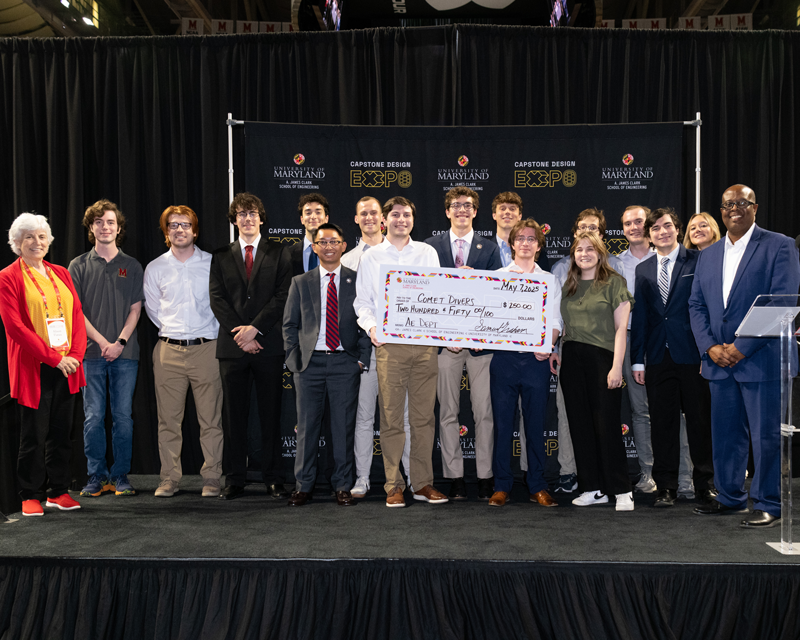 From airplane fleets for rapid humanitarian aid to a lunar rover named “SCORPION,” and from a hypersonic jet to a hydrogen-powered vertical take-off and landing vehicle, aerospace engineering teams innovated with the future in focus. From airplane fleets for rapid humanitarian aid to a lunar rover named “SCORPION,” and from a hypersonic jet to a hydrogen-powered vertical take-off and landing vehicle, aerospace engineering teams innovated with the future in focus.
Winning team Comet Divers’ “In-Situ Exploration of a Comet Tetrad” developed a mission aimed at intercepting and analyzing an Oort Cloud comet (the Oort Cloud is a giant swarm of objects and the most distant region of our solar system) using a fleet of four specialized spacecraft. While the mission supports deep space operations to reveal the secrets of the early solar system, it also contributes to planetary defense initiatives.
Sponsored by NASA Goddard Space Flight Center and advised by Goddard flight dynamics engineer Lecturer Brent Barbee, the project’s study of Oort Cloud comets increases understanding of distant threats, improving (as stated on the team poster), “our ability to detect, predict, and defend against future impacts that could endanger life on Earth.”
For aerospace engineering senior Dev Shanker, whose team created “Rack and Stack: Design of Payload Racks to Support Future Habitation Platforms and Exploration Missions,” testing their prototype was half the fun. To optimize the payload rack for scalability from lunar to Mars surface habitats, the prototype was tested in UMD’s Neutral Buoyancy Research Facility. The best part of the Expo itself? “I had the opportunity to go around and see projects from other teams and departments—aero’s lunar rover and mechanical’s assistive paddle design,” he said. “All our hard work has come to this one point, and it’s amazing.”
Fischell Department of Bioengineering Teams Devise Human Health Solutions
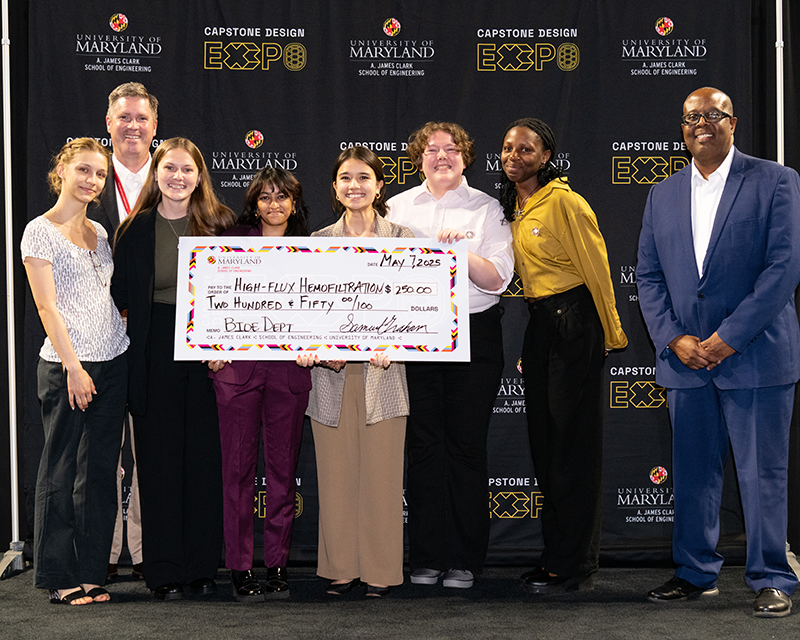 Bioengineering’s winning project, “High-Flux Hemofiltration System for Toxin and Solute Removal,” aimed at improving outcomes for critically ill patients by expanding access to more efficient extracorporeal detoxification for toxin removal. Advised by Senior Lecturer and Associate Chair for Community Engagement and Development Deborah Goldberg, the device built on proof-of-concept work done by bioengineering students to refine the system for clinical application, marking a key milestone in bringing the technology from bench to bedside. Bioengineering’s winning project, “High-Flux Hemofiltration System for Toxin and Solute Removal,” aimed at improving outcomes for critically ill patients by expanding access to more efficient extracorporeal detoxification for toxin removal. Advised by Senior Lecturer and Associate Chair for Community Engagement and Development Deborah Goldberg, the device built on proof-of-concept work done by bioengineering students to refine the system for clinical application, marking a key milestone in bringing the technology from bench to bedside.
Other bioengineering projects were aimed at preventing opioid overdose, ensuring patient safety through monitoring, enhancing the longevity of dental restorations, and more. Projects focused on improving pediatric health included the “Head Assessment Tool (HAT) for Improved Monitoring of Infant Head Growth” under the guidance of Assistant Professor Sara Molinari and physician-scientists Kevin Cleary and Youssef Kousa at Children’s National Hospital.
The aim? To improve on the current standard of care—a paper measuring tape—through the help of image analysis software. What the team created is an easy-to-use tool that allows for more accessible healthcare for patients and parents. Team member and bioengineering senior Katelyn Coste said that the tool would give physicians enough knowledge to know if further testing, such as an MRI, might be warranted.
Potential next steps? “We want to get more precise measurements, do some software tuning, and maybe even move into patenting the device, get trials done, and get the device into doctors’ offices.”
Department of Electrical and Computer Engineering Teams Increase Efficiency, Viability Across Industries
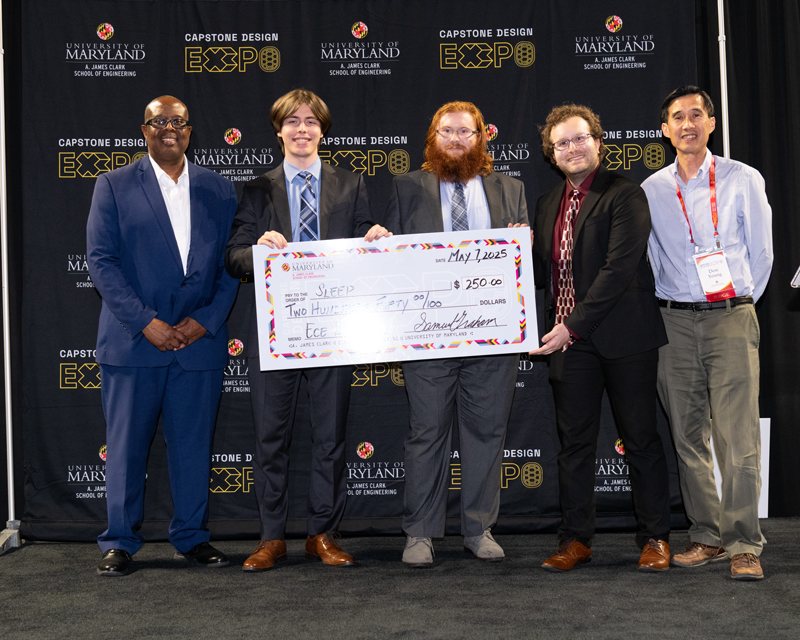 Projects geared at solving problems related to energy, communications, health care, environmental health, and musical applications were presented by this year’s cadre of Expo electrician and computer engineering participants. Of the 22 teams, project “Sleep Stage Classification from Non-invasive Device Data Using Machine Learning” came out on top. Projects geared at solving problems related to energy, communications, health care, environmental health, and musical applications were presented by this year’s cadre of Expo electrician and computer engineering participants. Of the 22 teams, project “Sleep Stage Classification from Non-invasive Device Data Using Machine Learning” came out on top.
The problem? Tracking sleep stages can give valuable insights into a person’s physical health and well-being, but current methods are expensive, uncomfortable, and limited to clinical settings. Advised by Distinguished University Professor Min Wu, the team focused on building a viable solution: developing a machine learning system for sleep state classification using non-invasive wearable data.
Other projects included the sleep-related “Spike Encoder and Neural Network Chip for Cognitive State Detection” from team Blink Twice for Help. With sleep quality, attention monitoring, and real-time cognitive state assessment increasingly critical in both research and consumer applications, the project addresses the need for an efficient, real-time, low-power system capable of decoding biosignals—indicated by eye movements—with applications ranging from sleep and attention monitoring in high risk environments, such as driving and flying, to cognitive performance analysis, education, and neurofeedback training.
Under the guidance of Professor Pamela Abshire, the team employed a custom mixed-signal integrated circuit designed to capture and classify neural signals. The applications for this project don’t stop at pilots and long-haul truck drivers, explained team member Sierra Raspa. “This type of architecture can also be expanded to help detect conditions like silent heart attacks—and even help with epilepsy.”
Department of Civil and Environmental Engineering Teams Innovate for Global Sustainability
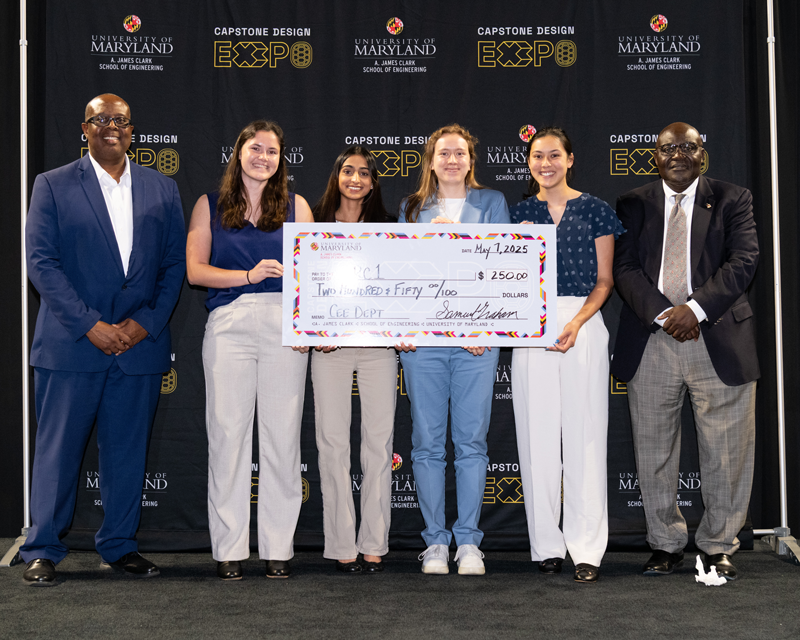 Civil and environmental engineering senior projects ranged from studying traffic flow in Maryland to converting plastic waste into building materials in Uganda. Working under the direction of Professor Deb Niemeier, the Clark Distinguished Chair in Energy and Sustainability, and with WWF as sponsor, the department’s winning project, ”Salonga National Park Health Clinic,” presents the design of a sustainable healthcare clinic for Monkoto, a remote region of Salonga National Park, a park of global ecological significance in the Democratic Republic of the Congo. Civil and environmental engineering senior projects ranged from studying traffic flow in Maryland to converting plastic waste into building materials in Uganda. Working under the direction of Professor Deb Niemeier, the Clark Distinguished Chair in Energy and Sustainability, and with WWF as sponsor, the department’s winning project, ”Salonga National Park Health Clinic,” presents the design of a sustainable healthcare clinic for Monkoto, a remote region of Salonga National Park, a park of global ecological significance in the Democratic Republic of the Congo.
In addition to his role as Expo project judge for civil and environmental and chemical and biomolecular engineering, restoration ecologist Paul Sturm also provided guidance to civil and environmental team EFFLUSENSE as they built their project, “A Smart Monitoring System to Optimize Bioreactor Gardens.” Sturm heads a Maryland nonprofit organization called Ridge to Reefs that works on food and water security—from Chincoteague, Virginia, to Hawaii and Micronesia. Using Sturm’s design, the team built a mini bioreactor garden they then used to monitor effluent (liquid waste), specifically excess nitrogen, which causes loss of aquatic biodiversity in the Chesapeake Bay. Working under Niemeier and sponsor Green Mechanics Benefit LLC, the project provides a case study to help optimize nature-based water filtration systems.
“It was a great project. I wanted to deploy it,” said Sturm, who often works with civil engineers and agronomists to develop water security solutions. “From my perspective it takes people from multiple disciplines to build solutions that work.”
Nii O. Attoh-Okine, chair of the Department of Civil and Environmental Engineering, echoed the sentiment, noting the importance of multidisciplinary efforts to move ideas forward. “With all eight departments here, you see there are some commonalities across the projects,” he said. “Going forward, we should find a way to ensure the students engage in the approach of multidisciplinary teamwork.”
To read more about all 134 student teams, visit the Capstone Design Expo site
VIP@Maryland at Expo
The Vertically Integrated Projects (VIP) Model for Experiential Learning creates long-term, large-scale projects that unite undergraduate education and faculty research, innovation, design, and entrepreneurship through multidisciplinary teams.
Two VIP@UMD teams competed at the 2025 Capstone Design Expo: the Wind TERPines team, which is exploring wind energy and its benefits under the guidance of Igor Sikorsky Distinguished Professor in Rotorcraft James Baeder; and Go With the Flow!, which is developing a series of instructional kits that can be used at home to support college-level fluid dynamics courses under the guidance of Associate Dean of Undergraduate Programs Ken Kiger, who, along with the Office of Global Engineering Leadership, has led the VIP efforts.
“VIP is a compelling model that has a demonstrated track record of making research more accessible for undergraduates at large scales, while also improving a sense of community and self-efficacy for students as they explore cutting-edge topics,” said Kiger.
Story photos by: Mike Morgan
Related Articles:
Meet the Clark Scholars Class of ’29
76 Undergrads Recognized at Annual Honors & Awards Celebration
Meet the A. James Clark Scholars Class of '27
Introducing the Clark Scholars Program Network
UMD Takes Second at VFS Design-Build-Vertical-Flight Competition
UMD Welcomes A. James Clark Scholars Class of '26
Chahat Deep Singh named recipient of Wylie Dissertation Fellowship
Ph.D. student Trisha Mittal named 2022 Adobe Research Fellow
Chahat Deep Singh named a Future Faculty Fellow
Sagnik Bhattacharya named a Future Faculty Fellow
May 15, 2025
|

